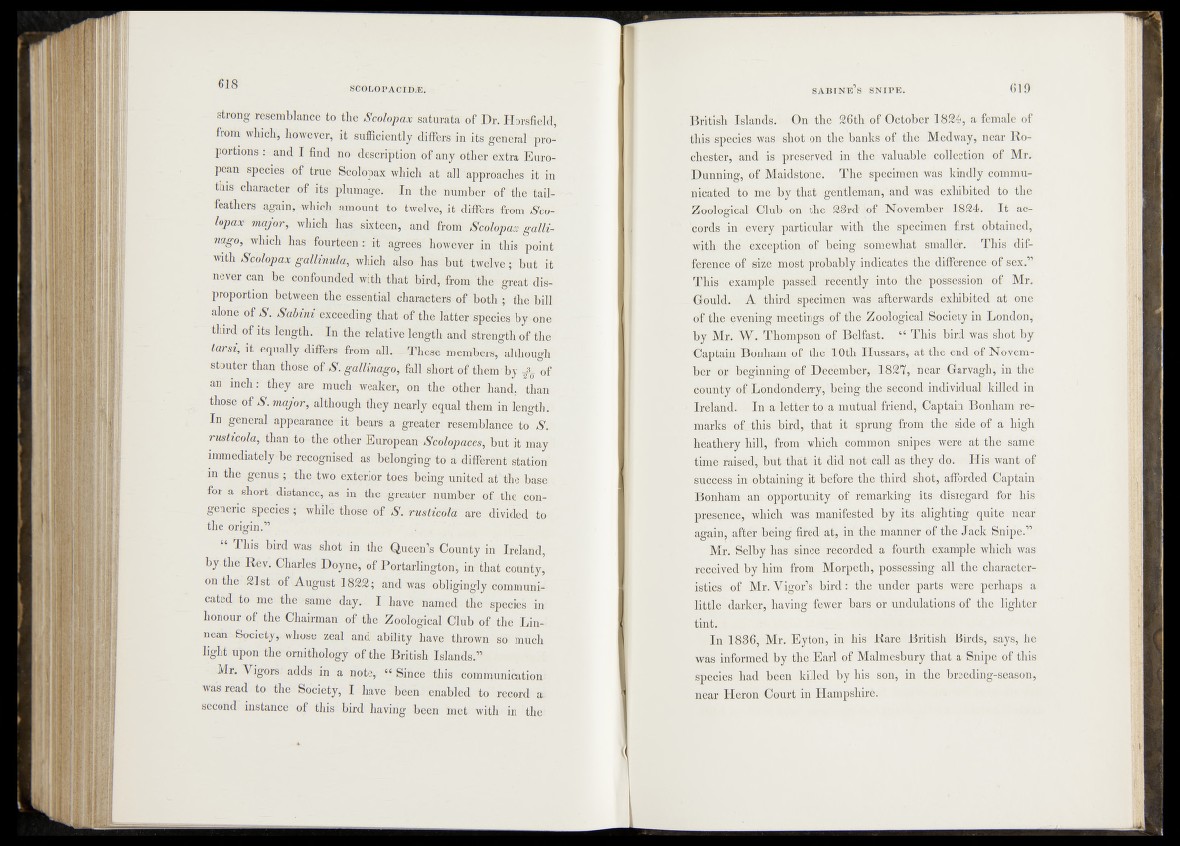
strong resemblance to the Scolopax saturate of Dr. Horsfield,
from which, however, it sufficiently differs in its general proportions
: and I find no description of any other extra European
species of true Scolopax which at all 'approaches it in
this character of its plumage. In the number of the tail-
feathers. again, which amount to twelve, it differs from Scolopax
major, which has sixteen, and from Scolopax galli-
naS°i which has fourteen: it agrees however in this point
with Scolopax gallinula, which also has but twelve; but it
never can be confounded with that bird, from the great disproportion
between the essential characters of both 1 the bill
alone of S. Sabini exceeding that of the latter species by-one
third of its length. In the relative length and strength'of the
tarsi, it equally differs from all. - These members, although
stouter than those of S. gallinago, fall short of them by ^ of
an inch: they are much weaker, on the other hand, than
those of S* major, although they nearly equal them in length.
In general appearance it bears a greater resemblance to S.
rusticola, than to the other European Scolopaces, but it may
immediately be recognised as belonging to a different station1
in the genus ; the two exterior toes being united afth e base ,
for a short, distance, as in the greater number of,,the congeneric
species; while those of S. rusticola are divided to
the origin/’ .
“ This bird was shot in the Queen’s County in Ireland,
by. the Rev. Charles Doyne, of Portarlington, in that county,
on the 21st of August 1822; and was obligingly communicated,
to me the same day. I have named the species in
honour of, the Chairman of the Zoological Club of the Lin-
nean Society, whose zeal and ability have thrown so much
light upon the ornithology of the British Islands.”
Mr. Vigors' adds in a note, “ Since this communication-'
was read to the Society, I have been enabled to record a.
second instance of this bird having been met with in the
British Islands. On the 26th of October 1824, a female of
this species was shot on the hanks of the Medway, near Rochester,
and is preserved in the valuable collection of Mr.
Dunning, of Maidstone. The specimen was kindly communicated
to me by that gentleman, and was exhibited to the
Zoological Club on the 23 rd' ;of November 1824. It accords
in every particular with the specimen first obtained,
with the exception of being somewhat smaller. This difference
of size most probably indicates the difference of sex.”
This example passed recently .into the possession of Mr.
Could. A third specimen was afterwards; exhibited at one
of the evening meetings of the Zoological Society in London,
by Mr. W . Thompson of Belfast. “ This bird was shot by
Captain Bonham of the 10th Hussars, at the end of November
or beginning of December, 1827, near Garvagh, in the
county of Londonderry, being the second individual killed in
Ireland. In a letter to a mutual friend, Captain Bonham remarks
of this bird, that it sprung from the side of a high
heathery hill, from which common snipes, were at the same
time raised, but that it did not call as they do. His want of
success in obtaining it before the third shot, afforded Captain
Bonham an Opportunity of remarking its disregard for his
presence, which was manifested by its. alighting quite near
again, aftér being fired at, in the, manner of the Jack Snipe.”
Mr. Selby has since recorded a fourth example which-was
received by him from Morpeth, possessing all the characteristics
of Mr. Vigor’s bird: .the under parts were perhaps a
little darker, having fewer bars or undulations of the lighter
tint.
In 1886, Mr. Eyton, in his Rare British Birds, says, he
was informed by the Earl of Malmesbury that a Snipe of this
species had been killed by his son, in the breeding-season,
near Heron Court in Hampshire.